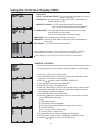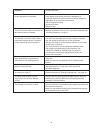
33
Troubleshooting Guide
Use the following information to solve common problems.
Symptom Possible Solutions
No picture Make sure that the power cord is plugged into a grounded
electrical outlet.
Make sure that the Power button is turned on.
Look in the left air vent to see if the lamp is on.
Make sure that the selected input source is connected to a
working component. If the other component is not working,
correct the problem with the other component.
If the RPTV is connected to a computer in RGB mode check to
see if the computer has gone to sleep and if so, press any key
on the keyboard to "wake up" the computer.
The picture is distorted or there is an
unusual sound.
Check if there is interference from other electrical appliance,
car, motorcycle or fluorescent light. Try moving the RPTV or
offending appliance to another location.
The color is abnormal. Check that the input source cable is connected securely and
correctly to the back of the RPTV.
There are abnormal patterns on the
Picture.
Check that the input source cable is connected securely and
correctly to the back of the RPTV.
Make sure that the video input source is within the range of
the RPTV. Compare the video input source's specifications
with the RPTV specifications.
The picture does not fill the whole screen.
If the TV, AV1, AV2 or component is being used with normal
480i input, Aspect button on the remote control to scroll
through various screen modes. (page 30)
There is a picture but no sound. Make sure that the volume is not turned down.
Make sure that the sound is not Muted.
Make sure that the internal speakers are not turned off.
Make sure that the audio input source cables are connected
securely and correctly.
The RPTV has pixels that are always dark.
The RPTV is manufactured using an extremely high level
of precision technology. However, sometimes pixels may
not display. Pixel defect within the industry specifications
are inherent to this type of product and do not constitute a
defective product.
There is video noise or artifact on the
picture.
When the RPTVs digital capabilities exceed a digital broadcast
signal, the signal is up-converted (increased) to match the
RPTVs display capabilities. This process may cause video
noise or artifact on screen.


















